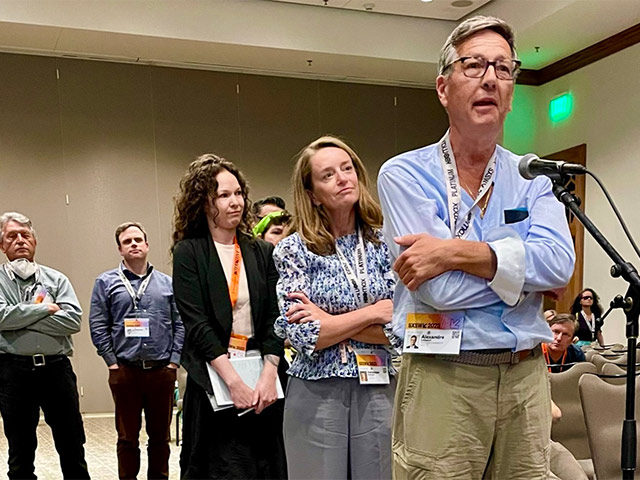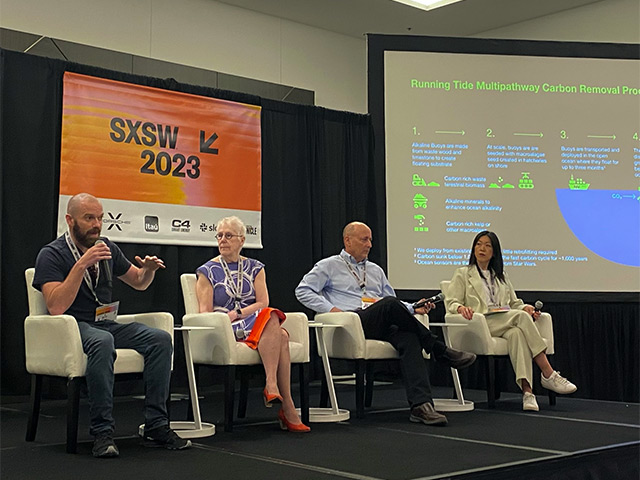39 North Showcases Climate-Smart Technologies on a Global Stage
The St. Louis Bioscience Ecosystem made its mark in Austin, TX at SXSW, an annual gathering of professionals from around the globe. The event celebrates the convergence of tech, film, music, education and culture. Attendees enjoyed engaging conversations and learned how our innovation community is working to make an impact on mitigating climate change, improving soil and gut health, and producing healthier and more abundant sources of food with a lower environmental footprint.
Plants, People & Planet: Microbes Rule Health
During the conference’s 2050 track, which featured a series of panels focused on long-term, big-picture innovations and challenges, Danforth Center Scientist Becky Bart, PhD and Washington University Professor Drew Schwartz, PhD, MD, and their co-panelists Nick Goeser, Carbon A List and Science Journalist Rodrigo Perez Ortega discussed the critical role microbes can have on the health of people and our planet. Speakers shared their perspectives about how science is radically rethinking agriculture & forestry practices, food systems design, personalized medicine, nutrition, pathways to optimal health and mitigating climate change. Becky shared the approach of the Center’s new Subterranean Influences on Nitrogen and Carbon Center as well as her team’s cutting-edge research to improve cassava, a food security crop. The discussion about the need for a greater understanding of the microbiome, microbial mechanisms, and the potential to heal some of our critical societal challenges generated nearly several questions from the audience, and the conversation continued outside the meeting room after the program concluded.

Attendees of the Plants, People, and Planet panel line up to ask questions of the panel experts.
Running Tide, the newest company to call 39 North home, was featured on two panels that examined how their ocean-based technologies can contribute to carbon removal. During the conference, the company announced a major deal with Microsoft to remove 12,000 tons of carbon over the next two years using breakthrough Running Tide technology.
How to Achieve Gigatonne Scale Carbon Removal
Running Tide’s Director of Strategic Partnerships Brad Rochlin explained how the company is testing a system to distribute small carbon buoys made from fast carbon-rich forestry residue and limestone into the open ocean hundreds of miles offshore. The buoys, which are seeded with algae, fix fast carbon through photosynthesis directly from the upper ocean fast carbon cycle. After less than three months, the buoy and algae lose buoyancy and sink rapidly. The carbon embodied in the buoy and algae will either be safely buried in ocean sediments or consumed by deep-sea marine life. Remarks by Brian’s co-panelists from Patch, Nox and CarbonCure Technologies illustrated that there is no shortage of carbon removal mechanisms to be tried and scaled, from cutting-edge direct air capture technology to leveraging nature’s toolbox using enhanced kelp and forest sequestration. These solutions need to be funded, developed, tested, certified and implemented today in order to reach climate goals for tomorrow.
As a young girl, Katie was always encouraged by her parents to read. “My mom gave me a chemistry book when I was about 10,” Katie said while recalling what got her hooked on science. Then as an undergraduate student, Professor Ginny Walbot reached out and said, “Come into my lab and I’ll teach you everything you need to know about plants.”
Climate Repair, Ocean Health and Carbon Removal

Running Tide CEO Marty Odin shares his passion for using ocean-based carbon removal technologies to address the impact of climate change.
Running Tide CEO Marty Odlin and his co-panelists from Carbon Cleve, Ocean Visions and Ocean Networks Canada explored the use of innovative approaches combined with the power of the ocean to restore the climate. Oceans naturally remove CO2, cycling it into the depths in a safe and permanent form. Blue carbon, iron fertilization, electrochemistry, and alkalinization represent a few ocean-based carbon removal pathways. Odlin emphasized the urgency of moving carbon from the fast to slow carbon cycle to restore ocean health and the scalability, durability and efficiency of using ocean-based CR approaches. Audience members were eager to engage with Marty and his co-panelists to learn more.